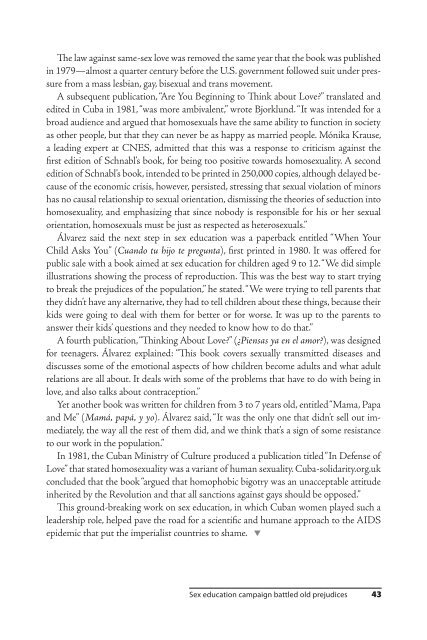LavenderRed_Cubabook
LavenderRed_Cubabook
LavenderRed_Cubabook
You also want an ePaper? Increase the reach of your titles
YUMPU automatically turns print PDFs into web optimized ePapers that Google loves.
The law against same-sex love was removed the same year that the book was published<br />
in 1979—almost a quarter century before the U.S. government followed suit under pressure<br />
from a mass lesbian, gay, bisexual and trans movement.<br />
A subsequent publication, “Are You Beginning to Think about Love?” translated and<br />
edited in Cuba in 1981, “was more ambivalent,” wrote Bjorklund. “It was intended for a<br />
broad audience and argued that homosexuals have the same ability to function in society<br />
as other people, but that they can never be as happy as married people. Mónika Krause,<br />
a leading expert at CNES, admitted that this was a response to criticism against the<br />
first edition of Schnabl’s book, for being too positive towards homosexuality. A second<br />
edition of Schnabl’s book, intended to be printed in 250,000 copies, although delayed because<br />
of the economic crisis, however, persisted, stressing that sexual violation of minors<br />
has no causal relationship to sexual orientation, dismissing the theories of seduction into<br />
homosexuality, and emphasizing that since nobody is responsible for his or her sexual<br />
orientation, homosexuals must be just as respected as heterosexuals.”<br />
Álvarez said the next step in sex education was a paperback entitled “When Your<br />
Child Asks You” (Cuando tu hijo te pregunta), first printed in 1980. It was offered for<br />
public sale with a book aimed at sex education for children aged 9 to 12. “We did simple<br />
illustrations showing the process of reproduction. This was the best way to start trying<br />
to break the prejudices of the population,” he stated. “We were trying to tell parents that<br />
they didn’t have any alternative, they had to tell children about these things, because their<br />
kids were going to deal with them for better or for worse. It was up to the parents to<br />
answer their kids’ questions and they needed to know how to do that.”<br />
A fourth publication, “Thinking About Love?” (¿Piensas ya en el amor?), was designed<br />
for teenagers. Álvarez explained: “This book covers sexually transmitted diseases and<br />
discusses some of the emotional aspects of how children become adults and what adult<br />
relations are all about. It deals with some of the problems that have to do with being in<br />
love, and also talks about contraception.”<br />
Yet another book was written for children from 3 to 7 years old, entitled “Mama, Papa<br />
and Me” (Mamá, papá, y yo). Álvarez said, “It was the only one that didn’t sell out immediately,<br />
the way all the rest of them did, and we think that’s a sign of some resistance<br />
to our work in the population.”<br />
In 1981, the Cuban Ministry of Culture produced a publication titled “In Defense of<br />
Love” that stated homosexuality was a variant of human sexuality. Cuba-solidarity.org.uk<br />
concluded that the book “argued that homophobic bigotry was an unacceptable attitude<br />
inherited by the Revolution and that all sanctions against gays should be opposed.”<br />
This ground-breaking work on sex education, in which Cuban women played such a<br />
leadership role, helped pave the road for a scientific and humane approach to the AIDS<br />
epidemic that put the imperialist countries to shame. <br />
Sex education campaign battled old prejudices 43


